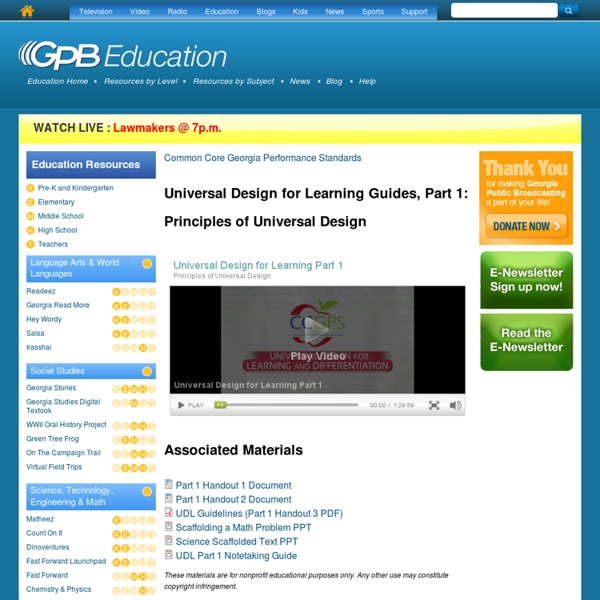



Universal Design for Learning - The ACCESS Project - Colorado State University The Best Practices through UDL video features faculty and students at Colorado State University discussing the benefits of UDL. Additional captioned formats are available, along with a transcript that includes descriptive audio. Universal Design for Learning (UDL) is a set of principles and techniques for creating inclusive classroom instruction and accessible course materials. = New in 2012 = Updated in 2012 UDL Teaching Resources: UDL: A Concise Introduction (HTML | PDF) How Do You Teach? UDL Technical Modules N. The Provost’s N. Universal Learning Design: Empowering the Next Generation Universal Design for Learning (UDL) - Everyone Can Learn - Center for Excellence in Disabilities Universal Design involves the widest range of people's abilities, to the greatest extent possible. Universal Design for Learning (UDL) is the design of instruction for all student use, without need for adaptation or specialized design. Teachers designing UDL classrooms should consider products and environments with a variety of characteristics that enhance all students' learning. UDL promotes a strong, yet flexible, foundation to meet a broader range of diverse abilities, disabilities, ethnicities, language skills and learning styles. The Center for Applied Special Technology (CAST) develops innovative technology based on the principles of UDL. What should educators know about UDL and their classroom? UDL classrooms can help reduce the amount of "special" modifications common in inclusive classrooms. UDL is based on nine principles that can make any classroom more inclusive for all students. Class climate: Adopt practices that respect both diversity and inclusiveness. Table of Contents
Lisa's Lingo: A UDL Classroom in Action Recently, a teacher, who I have much admiration for, asked me if I could share a UDL lesson with her. This was when I realized that, even those who seem to know, don't really understand UDL. So let's see what a UDL classroom in action looks like. But first, once again, I will explain UDL. UDL provides a blueprint for creating instructional goals, methods, materials, and assessments that work for everyone--not a single, one-size-fits-all solution but rather flexible approaches that can be customized and adjusted for individual needs." UDL is not a lesson plan, it is a program. Here is a typical day in my classroom. 8:45 - 9:10 - We unpack and listen to announcements. 9:10 - 10 - Math time. 10 - 10:45 - Reading time. 10:45 - 11 - Snack time. 11 - 12 - Social Studies. 12 - 1 - Language Arts - Sign of the Beaver projects are almost finished. Lunch time! 2 - 3 - Writing - During my mini-lesson, I write the steps to a personal essay. That's a typical day. This is a UDL classroom.
Disability Support Services - The George Washington University Home>Newsletters>Fall 2005>UDL Four Ways to Incorporate Universal Design for Learning into Your Assignment Instructions By Robbin Zeff, Assistant Professor of Writing Have you ever noticed how some products just make sense: a wider handle on a potato peeler for easier gripping or software that automatically corrects commonly misspelled words. In both instances these products were originally conceived to meet the needs of people with disabilities but ended up benefiting all users. This is the basis of universal design, a concept you can apply to designing and developing your assignment instructions. Universal design originated in architecture. Moreover, the usefulness of the modifications quickly started to extend beyond its original purpose of aiding those with disabilities. UDL asks the instructor to identify the key goal(s) and objectives of a course or an assignment and then provide multiple and flexible methods of presentation, expression, and engagement. For More Information on UDL
The Teaching Learning Center - Universal Design Techniques What is Universal Design? Prepared by Christopher Luna for the Teaching and Learning Center Universal Design (UD) is a set of principles which allows schools and other institutions to serve people with a variety of learning styles, abilities, experiences, and cultural backgrounds. UD allows us to provide instruction and materials which can be used by everyone. University of Washington Professor Sheryl Burgstahler, PhD, defines Universal Design of Instruction as “the design of instruction to be usable by all students, without the need for adaptation or specialized design” (“Universal Design of Instruction (UDI): Definition, Principles, Guidelines, and Examples,” DO-IT, University of Washington, 2008). Universal Design provides a means for students to access classroom material outside of the classroom environment. to listen to a podcast of a lesson in the privacy of his or her own home. allows the student a second chance to study and analyze the material. who cannot see or hear, for example. Dr.